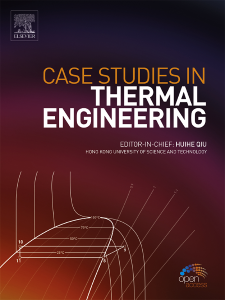基于流固耦合传热的薄板坯连铸模逆问题研究
IF 6.4
2区 工程技术
Q1 THERMODYNAMICS
引用次数: 0
摘要
薄板坯连铸 (TSCC) 工艺采用漏斗形铸模,增加了铸模结构和传热以及冷却水道的复杂性。本文提出了一个三维流固耦合模型,用于计算薄板坯铸型中的热通量。该模型根据从工厂模具和冷却水中收集的温度数据进行计算和验证。结果表明,宽面平均热通量和冷却水温差与测量值的偏差分别为 3.49 % 和 1.1 %,显示出良好的一致性。此外,还探讨了薄板模具几何形状对传热的影响。该模型计算出的热通量值在原始漏斗区上部比简化模型低约 13%,在下部低 2-7%。因此,该模型反映了漏斗形模具热通量的三维特征,为计算薄板模具热通量提供了一种新方法。本文章由计算机程序翻译,如有差异,请以英文原文为准。
Study on the inverse problem of thin slab continuous casting mold based on fluid-solid coupled heat transfer
The thin slab continuous casting (TSCC) process employs a funnel-shaped mold, introducing increased complexity to both the structure and heat transfer of the mold, as well as the cooling water channels. This paper presents a three-dimensional fluid-solid coupled model for calculating the heat flux in a thin slab mold. The model is calculated and validated based on temperature data collected from molds and cooling water in the plant. The results show that the deviations of the wide face average heat flux and cooling water temperature difference from the measured values are 3.49 % and 1.1 %, respectively, demonstrating good agreement. Moreover, the influence of the thin slab mold geometry on heat transfer is explored. The heat flux values calculated in this model are approximately 13 % lower than those in the simplified model in the upper part of the original funnel area, and 2–7% lower in the lower part. Therefore, this model reflects the heat flux's three-dimensional characteristics of the funnel-shaped mold, offering a novel approach to calculating the heat flux of the thin slab mold.
求助全文
通过发布文献求助,成功后即可免费获取论文全文。
去求助
来源期刊

Case Studies in Thermal Engineering
Chemical Engineering-Fluid Flow and Transfer Processes
CiteScore
8.60
自引率
11.80%
发文量
812
审稿时长
76 days
期刊介绍:
Case Studies in Thermal Engineering provides a forum for the rapid publication of short, structured Case Studies in Thermal Engineering and related Short Communications. It provides an essential compendium of case studies for researchers and practitioners in the field of thermal engineering and others who are interested in aspects of thermal engineering cases that could affect other engineering processes. The journal not only publishes new and novel case studies, but also provides a forum for the publication of high quality descriptions of classic thermal engineering problems. The scope of the journal includes case studies of thermal engineering problems in components, devices and systems using existing experimental and numerical techniques in the areas of mechanical, aerospace, chemical, medical, thermal management for electronics, heat exchangers, regeneration, solar thermal energy, thermal storage, building energy conservation, and power generation. Case studies of thermal problems in other areas will also be considered.
 求助内容:
求助内容: 应助结果提醒方式:
应助结果提醒方式:


